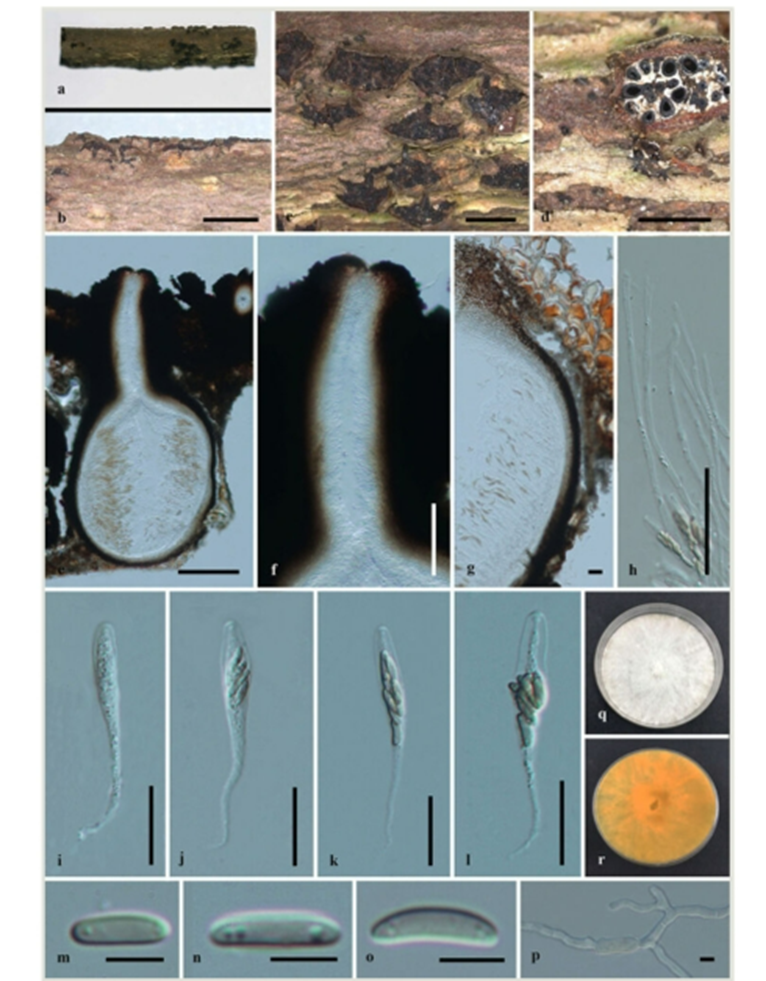 93
93
Paraeutypella guizhouensis L.S. Dissan., J.C. Kang & K.D. Hyde, sp. nov.2021
IndexFungorum IF557953 Facesoffungi number FoF09148
Holotype:kingdom: Fungi; phylum: Ascomycota; class: Sordariomycetes; order: Xylariales; family: Diatrypaceae; genus: Paraeutypella; specificEpithet: guizhouensis; country: China; stateProvince: Guizhou Province; county: Guiyang; locality: Guizhou University Garden (North); habitat: Saprobic on dead twigs.; fieldNumber: CLD018; identifiedBy: L.S.Dissanayake; type: Holotype; institutionID: HMAS 290654; collectionID: KUMCC 20 0016; institutionCode: Chinese Academy of Science, Kunming and Chinese Academy of Science Herbarium; collectionCode: Kunming Institute of Botany Culture Collection; datasetName: CLD018
Description:
Sexual morph: Stromata immersed in bark of dead branches, erumpent, aggregated, circular to irregular, superficial, carbonaceous. Ascomata 590–600 × 470–480 μm (x = 595 × 475 µm, n = 10), perithecial, with groups of 6–12 perithecia arranged in a valsoid configuration, subglobose, clustered, immersed in stromata, ostiolate. Neck 400–418 μm long (x = 409 µm, n = 10), papillate, central ostiolar canal filled with periphyses, 3–4 sulcate. Peridium 22–35 μm wide, composed of two layers of textura angularis; inner layer cells light brown to hyaline, outer layers cells dark brown to black. Hamathecium hyaline. Paraphyses 1–2 μm wide (x = 1.5 µm, n = 10), arising from base of perithecia, long, narrow, unbranched, septate, guttulate, narrowing and tapering towards apex. Asci 55–80 × 5-9 μm (x = 67.5 × 7 μm, n = 20), 8-spored, unitunicate, thin-walled, clavate to cylindrical clavate, long pedicellate (25–30 μm), with a J- apical ring. Ascospores 7–11 × 1–3 μm(x = 9 × 2 μm, n = 30), overlapping biseriate, allantoid, hyaline to light brown, smooth, aseptate, usually with 2–3 guttules.
Asexual morph: Undetermined.
Culture characteristics:Colonies on PDA, reaching 21 mm diam. after 2 weeks at 20 25 C, medium dense, circular to slightly irregular, slightly raised, cottony surface; colony from above: at first white, becoming buff; from below: yellowish-white at margin, yellow to brown at centre; mycelium yellowish.
Culture: Undetermined;
Habitat: Undetermined;
Distribution:China
GenBank Accession: ITS MW039348,β-tubulin MW239661;
Notes:Paraeutypella guizhouensis resembles P. vitis, which comprises stromata that are erumpent through bark, with elongated perithecial necks and allantoid, slightly to moderately curved ascospores (Glawe and Jacobs 1987). However, P. guizhouensis differs from P. vitis in having comparatively longer ostiolar necks and longer asci (55 80 × 5–9 μm), while P. vitis has comparatively shorter ostiolar necks and shorter asci (40–46 × 6–8 μm) (Glawe and Jacobs 1987). Paraeutypella vitis (UCD2428TX) differs phylogenetically from our new taxon in 14% (80/576) base pairs in the ITS and 10% (42/405) base pairs in β-tubulin. Thus, P. guizhouensis is introduced as a new species in Paraeutypella, based on its morphology, base pair differences and phylogenetic analyses (94% ML)
Reference: [1] Dissanayake, L. S. , Wijayawardene, N. N. , Dayarathne, M. C. , Samarakoon, M. C. , & Kang, J. C. . (2021). Diatrypella longiasca sp. nov. (diatrypaceae) from china. Biodiversity Data Journal, 9.

a–c. stromata on substrate; d. cross section of a stromata; e. vertical section through an ascostroma showing ostioles and perithecia; f. ostiolar canal; g. peridium; h. paraphyses; i–l. asci; m–o. ascospores; p. germinating ascospore; q, r. cultures on PDA from above and below after 6 weeks. Scale bars: 500 µm (b–d), 200 µm (e), 100 µm (f), 20 µm (g–l), 5 µm (m–p).

